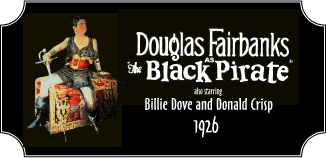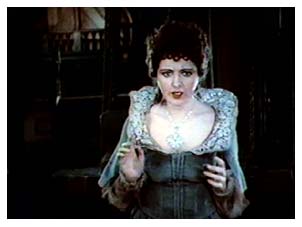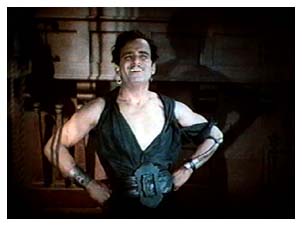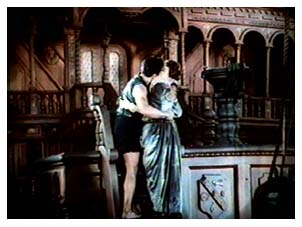

A treacherous lot of pirates have just captured and looted
another ship. As is their practice, they tie their captives to
the mast and then use the powder magazine to blow up the ship.
However, a father and son escape, but the father dies, and the
son vows revenge on the murderers. As he is stranded on the desert
isle, a small group of the pirates who killed his father come
ashore to bury their treasure. The son presents himself to them
as a candidate for inclusion among their number. To prove his
worth, he challenges the captain to a sword fight and kills him.
The lieutenant of the ship is unimpressed and says there is more
to being a pirate than sword tricks. With that, the son says
he will capture the next ship of prey single-handed, which he
 does. However, he has to use his
wits to keep the pirates from blowing up the ship and murdering
the crew and passengers. He suggests they hold the ship for ransom.
When a princess is discovered on board, he must also think quickly
to save her and urges the crew to use her as a hostage to insure
their ransom plot will succeed. However she must remain "spotless
and unharmed." The lieutenant, who has won her by drawing
lots and is displeased, but cannot go against the crew who has
been won over by this new leader. To keep the ransom plan from
succeeding, the lieutenant arranges to have the ship carrying
the ransom note blown up several hours after it leaves. When
the son, now known as The Black Pirate, tries to get the princess
away from the ship and safely on shore, he is caught and ordered
to walk the plank. One of the pirates, Mac Tavish, has taken
a liking to The Black Pirate and helps him cut the cords tying
his hands just before walking the plank. Everyone thinks The
Black Pirate is dead, but he swims ashore and goes for help to
come back, defeat the pirates and rescue the princess.
does. However, he has to use his
wits to keep the pirates from blowing up the ship and murdering
the crew and passengers. He suggests they hold the ship for ransom.
When a princess is discovered on board, he must also think quickly
to save her and urges the crew to use her as a hostage to insure
their ransom plot will succeed. However she must remain "spotless
and unharmed." The lieutenant, who has won her by drawing
lots and is displeased, but cannot go against the crew who has
been won over by this new leader. To keep the ransom plan from
succeeding, the lieutenant arranges to have the ship carrying
the ransom note blown up several hours after it leaves. When
the son, now known as The Black Pirate, tries to get the princess
away from the ship and safely on shore, he is caught and ordered
to walk the plank. One of the pirates, Mac Tavish, has taken
a liking to The Black Pirate and helps him cut the cords tying
his hands just before walking the plank. Everyone thinks The
Black Pirate is dead, but he swims ashore and goes for help to
come back, defeat the pirates and rescue the princess.
"In the tale that is spins, it's the weakest Fairbanks has ever had." (Variety)
"The picture is a series of robust scenes slung on a slender thread of a story." (The New York Times)
"While there is nothing unusual about the story, it, nevertheless, packs away a complete assortment of thrills." (Motion Picture Magazine)
Reviewers of the time were not kind to the story line of "The Black Pirate" which was written by Douglas Fairbanks under his usual pseudonym of Elton Thomas. Variety was the least kind in its comments going on to say, "It's simply a matter of scores of pirates in color and the Fairbanks curriculum of 'stunts.' Beautiful stuff and made as easy as possible on the eyes by the costuming and backgrounds in subdued colors. . . There is no dearth of action, but the story impresses as little more than an excuse."
The criticism went even further. "The 88 minutes the picture has been cut to is the tip-off that it's all ready to hop into a general release classification at any time with a quick turnover to the picture houses." Obviously, Variety was off-base in its prediction as "The Black Pirate" proved to be a resounding success and one of the top ten grossing pictures of 1926.
 As always, one has to remember
that a review is one man's (or woman's) opinion. Later in the
review, Variety questioned why Fairbanks chose this story
rather than the tried and true Sabatini story Captain Blood
which the reviewer believed was tailor-made for Fairbanks. It
would seem the most logical answer is that the story was just
recently made into a feature film by the Vitagraph Company (in
1924) starring J. Warren Kerrigan. Certainly Kerrigan couldn't
begin to compare to Fairbanks on the screen, but a remake so soon
would seem to be a logical reason for Fairbanks' decision to do
his own pirate story.
As always, one has to remember
that a review is one man's (or woman's) opinion. Later in the
review, Variety questioned why Fairbanks chose this story
rather than the tried and true Sabatini story Captain Blood
which the reviewer believed was tailor-made for Fairbanks. It
would seem the most logical answer is that the story was just
recently made into a feature film by the Vitagraph Company (in
1924) starring J. Warren Kerrigan. Certainly Kerrigan couldn't
begin to compare to Fairbanks on the screen, but a remake so soon
would seem to be a logical reason for Fairbanks' decision to do
his own pirate story.
Anyone who has not seen the film should not be quick to accept the contemporary reviewers' comments as fact. Admittedly, the story isn't going to win any prizes as a great piece of literature, but it's a solid story that holds the viewer's interest, sometimes with "on the edge of your seat" moments and sometimes excitement that makes the viewer cheer the good guys. It certainly contains the elements of a good story - a beautiful girl for the love interest, a damsel in distress, a last minute rescue, triumph of good over evil, a happy ending, characters who are well-defined, and even a few moments of humor.
A particularly tense, gripping piece of the story comes after the Black Pirate has single-handedly captured a ship to impress the pirates. One particularly dastardly (and repulsive, we might add) pirate peers through a hole to see a beautiful girl being hidden behind some folding doors. He slithers down to her room and pulls her from her hiding place. As her duenna tries to stop him, she escapes. Several of the pirates see her and chase after her as she runs right into the arms of the villainous lieutenant. Several of the pirates begin grabbing and mauling her to her (and our) disgust until the suggestion is made that they draw lots for her. The lieutenant is the winner.
During this time, the Black Pirate has almost convinced the crew that they should not blow up the ship, but, instead, save it for ransom. They demand some guarantee that the ransom offer will be accepted. At that moment, the Black Pirate looks over and sees the princess for the first time, cringing as the pirates draw lots for her. He lifts her beside him and tells the crew she will be their "surety."
There is a strong tenseness to this scene that raises the pulse as we wonder what will happen to the girl, for certainly the sexual implications are not absent (the pirates agree that she must remain "unspoiled and unharmed" if she is to maintain her ransom value). We are relieved to a great degree when she is rescued from the lieutenant, but she is not completely free of the pirates. If the ransom is not received by noon the next day, she is turned over to the villain who won her. This, although not an original situation, is nonetheless effective, and we spend the rest of the movie anxiously waiting for the girl to be rescued, hopefully still "unspoiled and unharmed."
Ever since Fairbanks made "The Mark of Zorro"
six years earlier, fans had come to expect him to make costume
pictures which actually were better suited to his athletic approach
to picture making than his earlier pictures -- and Fairbanks was
 smart enough to give his fans what
they wanted. "The Black Pirate" has some of the best
stunts of his career and possibly the single most remembered stunt
(sticking a knife into the sail and lowering himself down as the
knife rips through the canvas). Variety unfairly dismissed
the picture as "a matter of scores of pirates in color and
the Fairbanks curriculum of 'stunts'." That's just not so.
"The Black Pirate" could have never achieved the success
it did in 1926 and 1927 had there not been more than color photography
and stunts. There are many other so-called stars from the period
whose bread and butter was their stunts such as Richard Talmadge
or Al Wilson, for example. However, none of these ever had a
film that came even close to the success of "The Black Pirate,"
and we can safely assume that a larger budget, costumes and color
would not have brought them to equal status with Fairbanks' film.
smart enough to give his fans what
they wanted. "The Black Pirate" has some of the best
stunts of his career and possibly the single most remembered stunt
(sticking a knife into the sail and lowering himself down as the
knife rips through the canvas). Variety unfairly dismissed
the picture as "a matter of scores of pirates in color and
the Fairbanks curriculum of 'stunts'." That's just not so.
"The Black Pirate" could have never achieved the success
it did in 1926 and 1927 had there not been more than color photography
and stunts. There are many other so-called stars from the period
whose bread and butter was their stunts such as Richard Talmadge
or Al Wilson, for example. However, none of these ever had a
film that came even close to the success of "The Black Pirate,"
and we can safely assume that a larger budget, costumes and color
would not have brought them to equal status with Fairbanks' film.
No, Douglas Fairbanks wove more into his films, and his stunts did not overwhelm the stories and the characterizations which are so vivid in this film and which Variety fails to acknowledge. It should be kept in mind that we see some amazing stunts early on when the Black Pirate captures a ship by himself and then at the end when the final battle ensues, but there is little else in between. So, if the stunts are not there, what is it that holds the viewer for this 40-minute stretch of story? Again, the story is engrossing, and the characterizations are superb from the despicable lieutenant to the princess to the loyal Mac Tavish. And even though we only have the captain (very well portrayed by Anders Randolph) for the first 20 minutes of the film, his character is so thoroughly evil that we are delighted when the Black Pirate defeats him in a rousing sword fight.
Speaking of characters, Fairbanks teases us with the true identity of the Black Pirate throughout the film. As his father dies, he gives his son a ring. At this time, we are not aware of its significance, but it does raise questions in the viewer's mind. Later, when the Black Pirate talks to the crew about the ransom, he holds up the princess' necklace and says, "Here's our surety -- a princess -- this emblem marks here a princess of royal blood." At this, the princess looks at him quizzically. Although we're not sure why she reacts so, we later realize that she is puzzled how a mere pirate could know the meaning of the necklace, another hint that we are given. Later, the captain of the captured ship is sent to deliver the ransom letter. The Black Pirate slips him a note with his ring that says, "Show this ring to the Governor. Have him send against us a detachment of my best soldiers." The phrase "my best soldiers" intrigues us, as well as what the ring tells the governor. However, we know now that he is no mere pirate or sailor. It is only at the end that we find out he's a Duke and worthy of asking for the Princess' hand in marriage.
Although the film could not have succeeded without the elements
mentioned thus far, the color was certainly an added draw  for audiences, but it must be remembered that,
as with all of Fairbanks' endeavors, it was done well. It has
been noted that Fairbanks had wanted to do a pirate story for
some time, but he wanted to do it in color. The reason he had
not attempted it until this time was because the color process
had not developed to the point that it would meet his standards.
According to the New York Times reviewer, "Three
other important film features were previously produced wholly
in natural colors. They were 'The Glorious Adventure' (1924),
'The Toll of the Sea' (1922) and 'The Wanderer of the Wasteland.'
The latter was by all odds the best of the trio, but even that
Western subject could not be included in the same class with this
marvelous current offering."
for audiences, but it must be remembered that,
as with all of Fairbanks' endeavors, it was done well. It has
been noted that Fairbanks had wanted to do a pirate story for
some time, but he wanted to do it in color. The reason he had
not attempted it until this time was because the color process
had not developed to the point that it would meet his standards.
According to the New York Times reviewer, "Three
other important film features were previously produced wholly
in natural colors. They were 'The Glorious Adventure' (1924),
'The Toll of the Sea' (1922) and 'The Wanderer of the Wasteland.'
The latter was by all odds the best of the trio, but even that
Western subject could not be included in the same class with this
marvelous current offering."
After criticizing the "unnaturalness" of some previous color photoplays, Quinn Martin in The Arts (April, 1926) said, "Mr. Fairbanks has avoided all this by first choosing a subject adaptable to his scheme, then giving orders to everyone concerned that while the entire picture was to be turned out in color, not one blazing tint was to be stamped upon it. All were to be subdued -- browns, grays, unobtrusive reds. So that while the spectator fails to find any carnival hues shooting across the canvas where this cinema is shown, still the deep, rich brown of his pirate ships is there; the faded, grade and brown clothing of the players are there; the weak, green waters of the sea are there."
Robert Sherwood in Life Magazine (March 25, 1026) said, "With characteristic taste, he has toned down his tints to such an extent that the spectator is almost unconscious of them; he has made no attempt to duplicate the realism of a mirror, but has made his scenes in the form of impressionistic paintings. Thus, 'The Black Pirate' stands at the top of all the movies I have seen in point of rich, glamorous beauty."
The reason Fairbanks' experiment with the two-strip technicolor process surpassed the films mentioned above (remember the Bal Masque sequence in "The Phantom of the Opera" (1925) was also done in this process) was his attention to detail in adapting to the limitations of the process. Experiments with color were done with costumes and scenery before he proceeded with the filming. Changes had to also be made between the outdoor and indoor scenes because the process filmed differently in the two different kinds of light. The two strips referred to in this technicolor process were red-orange and blue-green. These were cemented together to gain the desired effect and projected in this manner. Yellow was not recorded until the three-strip technicolor process was introduced in 1932.
Sherwood went on to say, "The arrangement and composition of the scenes is simply extraordinary; furthermore, it is never obvious. It is the work of artists who know how to reach the brain through the eye. . . Suffice it to say that the audiences at 'The Black Pirate' gasp with wondering approval as each new visual thrill is revealed."
The New York Times said, "The unrivalled beauty
of the different episodes is mindful of paintings of the old masters
. . ."
Obviously, Fairbanks would only settle for the best, and that insistence on quality is almost certainly why the color on "The Black Pirate" is still enjoyable today. But the quality is there in every other respect - sets, costumes, action, realism, the stunts, supporting actors and actresses and more. Keep in mind that when reviewers criticized a Fairbanks film for not meeting their expectations, it is only in comparison to other Fairbanks films, not the general output of films of which so few could even begin to compete with a Fairbanks production. As a matter of fact, it should be noted that although reviewers criticized a "weak" story, they were still complimentary of the film as a whole.
The New York Times said, "This is a production which marks another forward stride for the screen, one that the boy and his mother will enjoy and one that is a healthy entertainment for men of all ages." Motion Picture Magazine (June, 1926) said, "'The Black Pirate' takes rank with the previous spectacles. While there is nothing unusual about the story, it, nevertheless, packs away a complete assortment of thrills. It holds one in a tight embrace, thru its melodramatic highlights and its atmosphere of natural color. And Photoplay (May, 1926) praised it by saying, "A roistering tale of the Spanish Main is 'The Black Pirate,' and I pity the man whom it does not waft back to the days of his boyhood, when he dreamed of himself climbing aboard the pirate craft and cleaning the seas of the bloodthirsty buccaneers." Even Variety admitted, "Getting down to facts is to say that Fairbanks is still 'there' and this picture should get a lot of 'dough'."
The Kino-Image DVD release can only be described as exquisite. Not only is the picture quality superb, the colors are magnificent and far better than one would expect from a film of this age which was filmed in a less than perfect color process. The original Mortimer Wilson score is brought to us by Robert Israel, and it is excellent -- very appropriate throughout and not intrusive. An extremely absorbing 18 minutes of outtakes is provided with excellent informative commentary by Rudy Behlmer, well worth the price of the DVD by itself. Rare photographs are also provided
Note: The photo above right is actually Doug kissing Mary Pickford who is in Billie Dove's dress and wig. This is one of many interesting facts you'll learn in the special outtakes supplement that comes with the DVD.